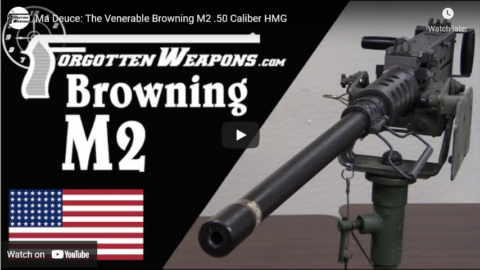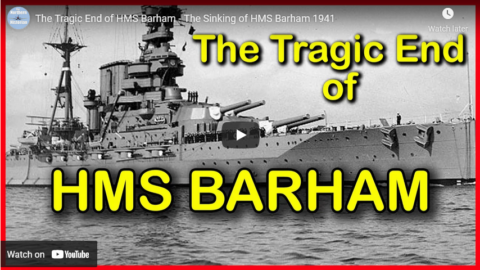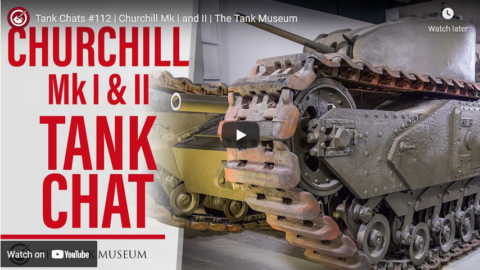World War Two
Published 3 Jul 2021It’s that time of the year again — the time when the Axis Powers drive deep into the Soviet Union. Fall Blau is the name of this year’s huge offensive, and it begins this week, making great gains from the very beginning, but the Axis Powers are also making big gains this week in North Africa, taking Mersa Matruh and pushing to within 100 km of Alexandria. Can nothing stop them?
(more…)
July 4, 2021
Fall Blau Begins, Stalin Caught off Guard Again – 149 – WW2 – July 3, 1942
Ma Deuce: The Venerable Browning M2 .50 Caliber HMG
Forgotten Weapons
Published 25 Dec 2020http://www.patreon.com/ForgottenWeapons
https://www.floatplane.com/channel/Fo…
Cool Forgotten Weapons merch! http://shop.bbtv.com/collections/forg…
The M2 Browning machine gun was first conceived in 1918, as a request by General John Pershing of the AEF for a large-caliber anti-aircraft and antitank machine gun. John Browning scaled his M1917 water-cooled .30 caliber design up to .50 caliber, and the first prototypes were test fired in November of 1918. Impetus behind the project faltered after the Armistice, but Colt continued to develop the gun during the 1920s and 1930s. It was first adopted in 1922 by the US Coastal Artillery as an anti-aircraft gun, but significant manufacture would not come until World War Two. By this time, the gun’s main role had shifted, from antitank to being an aircraft armament, and some 2 million were made during World War Two, primarily as aircraft guns.
The M2 remains in service today, highlighting the brilliance and longevity of John Browning’s designs.
Contact:
Forgotten Weapons
6281 N. Oracle #36270
Tucson, AZ 85740
July 2, 2021
Japan’s Institutionalization of Rape – WAH 037 – June 1942, Pt. 2
World War Two
Published 1 Jul 2021During the occupation of South-East Asia, Japan builds a large system of institutionalised rape to “keep their soldiers happy”. Meanwhile, Allied refugees from Burma find a safe haven in India, but for some, hardship continues.
(more…)
June 30, 2021
The Red Orchestra – The Nazi-Soviet Spy Dance – WW2 – Spies & Ties 04
World War Two
Published 29 Jun 2021An extensive network of spies and radio operators are gathering intelligence and sending it to Moscow from Western Europe. They are a colourful group of people who go by the name of Die Rote Kapelle, or Red Orchestra.
(more…)
June 29, 2021
QotD: Carrier dive bombers in the early Pacific war
The Japanese Nakajima B5N “Kate” (235mph, 1 x 7.7mmm mg, 1760lbs torpedo or bombs, 1,075 mile range) torpedo bomber had been introduced in 1941, and was the mainstay of the early years of the wartime Japanese carrier operations. It had good range, was reliable, and had a good payload. But it still lacked armour or self-sealing fuel tanks. As a result it was desperately vulnerable to daytime operations against reasonable fighter opposition.
Almost exactly the same could be said for the American Douglas Dauntless dive bomber (255mph, 2 x 0.5 and 2 x 0.3 mg, 1,200lbs bombs, 1,115 mile range). Arrived at the same time, same strengths, similar weaknesses. Like all American aircraft it could absorb considerably more damage than any Japanese plane, but like all daylight attack aircraft, its top speed made it a sitting duck against organized fighter defenses. The greatest success of the Dauntless was at Midway, where the sacrificial run of the TBD Devastator torpedo bombers fortuitously arrived just far enough in advance to pull the entire Japanese fighter cover away and allow the Dauntlesses exactly the sort of unopposed attacks that the theoretically inferior Japanese “Val” dive bombers had enjoyed at Ceylon and Coral Sea. The increased success of the Dauntless later in the war was in direct parallel to the increased ability of American fighters to clear a path. By the time of the sinking of the Yamato in 1945, Dauntless formations always had almost completely unopposed runs. (Perhaps that is why it continued in operation when every other contemporary aircraft had been replaced?)
Nigel Davies, “Comparing naval aircraft of World War II”, rethinking history, 2010-12-20.
June 28, 2021
Colt R75A: The Last Commercial BAR (With Shooting)
Forgotten Weapons
Published 2 Mar 2018The R75A was the last version of Colt’s commercial BAR, with 832 made between August and December of 1942 for the Netherlands Purchasing Commission. It was a derivative of the commercial R75 BAR, with a pistol grip, magazine well cover, and ejection port cover. The R75A added on a folding bipod and a detachable barrel functionality, albeit not of the most elegant sort. To remove the barrel, one first used the lever under the muzzle to detach the gas block from the barrel by sliding it rearwards. Then a tool or cartridge tip was used to pry open the barrel locking lever at the front of the receiver, which then allowed the barrel to be rotated about 60 degrees to unlock its interrupted threads and remove it.
http://www.patreon.com/ForgottenWeapons
Cool Forgotten Weapons merch! http://shop.bbtv.com/collections/forg…
If you enjoy Forgotten Weapons, check out its sister channel, InRangeTV! http://www.youtube.com/InRangeTVShow
June 27, 2021
Fall Blau Starts … or Does it? – WW2 – 148 – June 27, 1942
World War Two
Published 26 Jun 2021Fall Blau, the huge Axis summer offensive in the Soviet Union, is supposed to being this, but is postponed to next. The smaller Operation Fridericus II does begin though, and what does Josef Stalin make of that and the intelligence he’s received? Meanwhile in North Africa, after the fall of Tobruk, the British 8th Army gets a leadership change, but Erwin Rommel is still on the move eastward into Egypt. Where will the Allies try to hold him? Half the world away, the Allies begin to establish a base at Milne Bay, New Guinea. It’s a start, a small one, but a start.
(more…)
The Tragic End of HMS Barham – 25 November, 1941
The Northern Historian
Published 5 Mar 2021On the 25th of November 1941, the Royal Navy’s 1st Battle Squadron consisting of HMS Queen Elizabeth, HMS Valiant and HMS Barham along with eight destroyers were on a hunt in the central Mediterranean looking for Italian convoys.
Also on the hunt was a German U-Boat and their paths were on a collision course. A collision that would send HMS Barham to the floor of the Mediterranean Sea along with over 800 of her crew.HMS Barham had begun her service with the Royal Navy during World War 1 and played a role during the Battle of Jutland.
Following World War 1, HMS Barham had several refits and operated in the Atlantic Fleet and the Mediterranean Fleet during the inter-war years.
During World War 2, HMS Barham took part in the the Battle of Dakar before taking part in escort convoys in the Mediterranean.
In November of 1941, during an escort mission, HMS Barham was attacked by U Boat U-331 under the command of Hans-Diedrich von Tiesenhausen.
The attack caused a huge explosion in her magazine and rapidly sank, killing over 800 men.
June 25, 2021
The Birth of the Manhattan Project – WW2 Special
World War Two
Published 24 Jun 2021When nuclear fission was discovered, scientists theorized it could be used in an atomic bomb. Thus, the American Army sets up one of the biggest research projects in history: The Manhattan Project.
(more…)
June 23, 2021
The RAF and Luftwaffe Bombers of Western Europe – WW2 Special
World War Two
PUblished 22 Jun 2021What aircraft are being sent out by commanders like Hermann Göring and Arthur Harris to blitz and firebomb enemy cities? Watch the video to learn the specs of the Handley Page Halifax, Avro Lancaster, Junkers Ju-88, Dornier Do-17, Dornier Do-217, and Heinkel He-111 as they fly in their respective 1,000 Bomber Raids and Baedeker Blitz.
(more…)
Tank Chats #112 | Churchill Mk I and II | The Tank Museum
The Tank Museum
Published 4 Dec 2020Tank Museum Historian David Fletcher discusses the British Second World War Churchill Mark I, the very first Churchill, as well as its successor, the Mark II. This chat also covers the development of the A20 prototype and how this became the production Mark I variant. The Churchill displayed is actually a Mark II made to look like a Mark I, and is the oldest surviving Churchill in the UK.
Support the work of The Tank Museum on Patreon: ► https://www.patreon.com/tankmuseum
Visit The Tank Museum SHOP & become a Friend: ► tankmuseumshop.orgTwitter: ► https://twitter.com/TankMuseum
Instagram: ► https://www.instagram.com/tankmuseum/
#tankmuseum #tanks
QotD: Churchill’s support for Stalin
Churchill threw all of his support behind Stalin’s armies despite Stalin’s alliance with Hitler during the first 21 months of the war — the USSR having invaded the same number of countries as Nazi Germany (seven), having supplied the German Wehrmacht as it invaded France and the Low Countries, and having literally fueled the Luftwaffe as it bombed London in 1940.
This support was more than rhetorical. In a gesture of astonishing (and short-sighted) selflessness, Churchill responded to news of Nazi Germany’s invasion of the Soviet Union by sending Stalin 200 brand-new Hawker Hurricane pursuit planes which had been pledged to defend Singapore against Japanese attack. Churchill then “re-gifted” Stalin 200 Tomahawk fighters and 300 Douglas A-20 Havoc bombers from Britain’s own Lend-Lease consignments, and shipped Stalin 2,000 tonnes of processed aluminum for Soviet warplane factories, despite it being desperately needed at home.
Even more striking was Churchill’s decision to ship Stalin nearly 600 tanks, which helped tip the balance in the Battle of Moscow in December 1941. Churchill even agreed to strip Cairo command of hundreds more tanks in 1942, routing them to Stalin’s USSR via Iran to bail out the Red Army at Stalingrad, which left Egypt vulnerable to Rommel’s Afrika Korps.
Churchill doubled down on his pro-Soviet policies even in areas where Britain had her own clients, such as Yugoslavia. Despite hosting the Yugoslav exile government in London, by September 1943, Churchill abandoned that government’s commander on the ground and threw his full support behind Stalin’s man, Josip Broz (“Tito”). Bamboozled by a Soviet smear campaign against Colonel Draža Mihailovic, Churchill cut off Mihailovic’s Chetniks and shipped Tito more than 100 times more war materiel over the next nine months than Mihailovic had received in the previous two years.
Sean McMeekin, “Churchill’s enigma: the real riddle is why he cozied up to Stalin”, Spectator, 2021-03-21.
June 22, 2021
QotD: The “Stringbag”, formally known as the Fairey Swordfish
The British torpedo bomber [of 1939] was the Fairey Swordfish (138mph, 2 x .303mg, 1,600lbs torpedo or bombs — later rockets, 1,030 miles range). A slow but reliable biplane, with more lift and range than the [American Douglas TBD] Devastator, and more combat survivability than the [Japanese Yokosuka B4Y] “Jean”. (It frequently astounded even the crews how much damage a Swordfish could absorb and keep flying. Ragged anti-aircraft holes in the wings and tail and fuselage, lines of tracer holes across various surfaces, broken struts, cut control cables, the Swordfish would absorb them all and make it home.) Nevertheless the Swordfish was quickly proved to be a deathtrap for daylight operations against an enemy with fighter cover, and was scheduled for replacement by a more modern torpedo bomber for combat ops. Yet, amazingly, the Swordfish was the only allied pre-war naval carrier aircraft still in production when the war ended.
There are three reasons for this feat. The first is that the British were early adaptors of night operations, and performed successful Swordfish strikes (such as the amazingly successful strike at the Port of Taranto which crippled or sank several major warships – becoming the Japanese model for Pearl Harbor), and successful night attacks at sea once the second innovation came in. This was the development of airborne radar, which was first operational on Swordfish operating on British carriers six months before Pearl Harbor. The British were to hold this unique ability to use radar for carrier aircraft operations for a couple of years before the Americans deployed similar concepts in 1943. They were to hold their unique advantage of night-time strikes also. (Both the Japanese and Americans lost many pilots over the next few years in strikes that failed to get home before dark!) So the Swordfish could soldier on under the cover of night, and continued to be useful as a strike aircraft long after its use in daytime had been demonstrated to be suicidal by the easy slaughter of those attempting to attack the Scharnhorst and Gneisenau during the Channel Dash in 1941.
The third, and unexpected reason, why the Swordfish was still in production at the end of the war, was that its unrivalled flying characteristics made it the only aircraft capable of surviving operations from small escort carriers operating in the Arctic Circle in bad weather. Whereas more modern, higher speed aircraft, like the Hurricane, Wildcat and Avenger could work from escort carriers in calmer seas, none of those would even consider operations under the sort of conditions that a Swordfish could easily manage. So the venerable old bus continued to serve successfully purely in an anti-submarine role until the final days of the war. This was not because there weren’t many better aircraft available, but simply because no other aircraft available could do the job as well. An example of a World War Two aircraft still having a (slightly reduced) role, long after being technically obsolete — see the many inadequate fighters that lived on as very successful night fighters. (Though the fact that “modern” B-52s are scheduled to still be operational 80 or 90 years after their initial deployment shows that new roles are always possible for reliable old aircraft, even when their technology is fifty years out of date.)
Nigel Davies, “Comparing naval aircraft of World War II”, rethinking history, 2010-12-20.
June 21, 2021
Turner Semiauto SMLE Conversion
Forgotten Weapons
Published 12 Nov 2016Cool Forgotten Weapons Merch! http://shop.bbtv.com/collections/forg…
Russell Turner was a Pennsylvania gunsmith and inventor who developed this semiautomatic conversion of an SMLE bolt action rifle circa 1940. It was intended for trial and potential sale to the Canadian military, as it would allow them to retrofit existing rifles into semiautomatic configuration and still use existing supplies of .303 British ammunition. Rather than try to devise a reliable system to rotate the original Enfield bolt, Turner replaced the bolt entirely, using instead a side-tilting design much like what he used in his M1 Carbine trials rifle for the US military. This was coupled with a long stroke gas piston and a hammer firing trigger mechanism.
Reportedly the rifle was tested by Canadian authorities, and performed quite well, with the adjustable gas system allowing it to function reliably even in temperatures of 25 below zero (where the Garand, tested alongside, experienced problems). However, Turner’s rifle was deemed too complex for military adoption.
That decision against the rifle was probably the right one for Canada, although Turner’s conversion is one of the better semi auto bolt acton conversions I have handled. It was remarkably non-awkward — that may not sound like much to crow about, but it sets a pretty high standard for this type of rifle.
June 20, 2021
Tobruk: A second siege? – WW2 – 147 – June 20, 1942
World War Two
Published 19 Jun 2021Two convoys head from opposite ends of the Mediterranean to supply Malta, hoping to run interference for each other, and the Battle of Sevastopol continues as the Axis slowly wear down the Soviet defenders, but the big news is Erwin Rommel’s continued advances in North Africa, defeating the 8th Army again and again. Can the Allies hold Tobruk? Will they even try? Watch and find out.
(more…)








